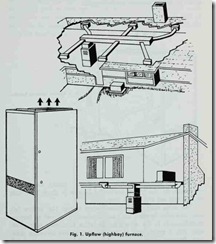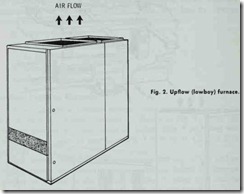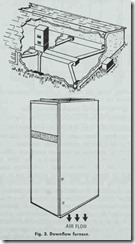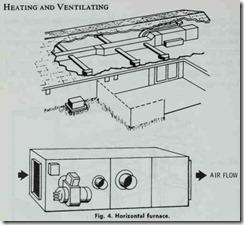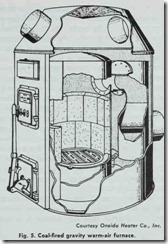Furnace Fundamentals
The American Society of Heating, Refrigerating and Air Conditioning Engineers (ASHRAE) defines a furnace as being a complete heating unit for transferring heat from fuel being burned to the air supplied to a heating system. The Standard Handbook for Mechanical Engineers (Baumeister and Marks Seventh Edi tion, 12-104) provides a definition that differs only slightly from the one offered by the ASHRAE. It defines a furnace as being a self-enclosed, fuel-burning unit for heating air by transfer of combustion through metal directly to the air. Contained within these closely similar definitions are the two basic operating prin ciples of a furnace; that is to say, some sort of fuel is used to produce combustion and the heat resulting from this combustion is transferred to the air within the structure. Note that air and not steam, water, or some other form of liquid is used as the heat conveying medium. This is the feature which distinguishes warm air heating systems from the other types (see Chapter 6. WARrvi AIR HEATING SYSTEMS).
Most modern furnaces are used in warm-air heating systems in which the furnace is a centralized unit, and the heat produced in the furnace is forced or rises by means of gravity through a system of ducts or pipes to the various rooms in the structure. This is what one commonly refers to as a central heating system. In other words, the furnace is generally in a centralized location within the heating system in order to obtain the most economical and efficient distribution of heat (although this is not an absolute necessity when a forced warm-air furnace is used).
Ductless or pipeless furnaces are also used in some heating applications, but are limited in the size of the area which they can effectively heat. They are installed in the room or area to be heated, but are provided with no means for distributing the heat beyond the immediate adjacent area. This is a far less efficient and economical method of heating than the central heating system, but is found to be adequate for a room, an addition to an existing structure, or a small house or building.
CLASSIFYING FURNACES
There are a number of different ways in which furnaces can be classified. One of the more popular methods is based on the type of fuel used to fire the furnace. Using fuel as classificatory criteria, the following four types of furnaces are recognized:
1. Gas-fired furnaces,
2. Oil-fired furnaces,
3. Coal-fired furnaces,
4. Electric-fired furnaces.
The first three categories of furnaces use a fossil fuel to pro duce the combustion necessary for heat transfer. The last one, namely electric-fired furnaces, uses electricity. Whether or not electricity can be justifiably called a fuel is not of great importance here, because in this particular instance it functions in the same manner as the three fossil fuels: it heats the air being distributed.
Furnaces can also be classified by the means with which the heated air is distributed to the room (or rooms) in the structure. This method of classifying furnaces establishes two broad classes:
(1) gravity warm-air furnaces and ( 2) forced warm-air furnaces.
The gravity warm-air furnaces rely primarily upon the principle of gravity for circulating the heated air. Because warm air is lighter than cold air, it will rise and pass through ducts or directly into the rooms to be heated. After passing off its heat, the now cooler and heavier air descends through returns to the furnace where it is reheated. Gravity-type furnaces represent the earliest designs used in warm-air heating systems. They were sometimes equipped with fans (integral or booster) to increase the rate of air flow. They have been largely replaced in popularity by forced warm-air furnaces which are equipped with integral fans.
Forced warm-air furnaces are often divided into three prin cipal classes based primarily upon the location on the furnace of the warm air discharge outlet and the return air inlet. Further more, there are additional design considerations dependent upon the planned location of the furnace which also enters into the classification of warm-air furnaces. This classificatory system results in three types or classes of warm-air furnaces:
1. Upflow furnaces,
a. Upflow highboy furnaces.
b. Upflow lowboy furnaces.
2. Downflow furnaces,
3. Horizontal furnaces.
Upflow Highboy Furnace
A typical upflow highboy furnace (also referred to as an up flow furnace or a highboy furnace) is shown in Fig. 1. These are compact heating units that stand no higher than 5 or 6 feet and occupy a floor space of approximately 4 to 6 sq. ft. (2 ft. x 2 ft. or 2 ft. x 3 ft. ) .
The heated air is discharged through the top of the upflow furnace (hence the name) and the return air enters the furnace through air intakes in the bottom or sides. Cooling coils can be easily added to the top of the furnace or in the duct system.
Upflow Lowboy Furnace
The upflow lowboy furnace (also referred to as an upflow furnace or lowboy furnace) (Fig. 2) is designed for low clear ances and stands only about 4 to 4lh feet high. Although shorter than either the upflow highboy or downflow types (see below), it is longer from front to back.
Both the return air inlet and the warm air discharge outlet are usually located on the top of the lowboy furnace. The lowboy furnace is found in heating installations where the ductwork is located above the furnace.
Downflow Furnace
Fig. 3 shows an example of a downflow furnace (also referred to as a counterflow furnace or a downdraft furnace). It is very similar in size and shape to the upflow furnace, but it discharges its warm air at the bottom rather than the top. The return air intake is located at the top.
A downflow furnace is used primarily in heating installations where the duct system is either imbedded in a poured, concrete slab or suspended beneath the floor in a crawl space.
Horizontal Furnace
A horizontal furnace (Fig. 4) is designed for installation in a low, cramped space. They are often installed in attics (and referred to as attic furnaces) where they are positioned in such a way that a minimum of ductwork is used. This type of furnace is also frequently installed in crawl spaces.
Although dimensions will vary slightly among the various manufacturers, the typical horizontal furnace is about 2 ft. wide by 2ft. high and 4 to 5 ft. long.
The terms used in this classificatory system (i.e. upfiow fur nace, downflow furnace, etc.) are commonly employed by furnace manufacturers in the advertising literature describing their prod ucts. This is equaly true of their installation and operation man uals. Because of the widespread usage of these terms, they will be employed in the more detailed description of furnaces in the chapters that follow this one.
GRAVITY WARM-AIR FURNACES
Gravity warm-air furnaces rely upon the fact that warm air is lighter than cold air. As a result, the warmer air rises through the ducts or pipes in the structure, gives off its heat to the rooms, and descends to the furnace as it becomes cooler and heavier. It is then reheated and rises once again to the rooms. A continuous circulation path is thus established through the heating and cool ing of the air. Sometimes a fan is added to increase the rate of flow, but the primary emphasis is still the effect of gravity on the differing weights of air.
Depending upon the design , a gravity warm-air furnace will fall into one of the following categories:
1. A gravity warm-air furnace without a fan.
2. A gravity warm-air furnace with an integral fan.
3. A gravity warm-air furnace with a booster fan.
Each of these three categories represent different types of warm-air furnaces used in central heating systems.
Any gravity warm-air furnace not equipped with a fan relies entirely upon gravity for air circulation. The flow rate is very slow and extreme care must be taken in the design and placement of the ducts or pipes. Sometimes an integral fan is added to re duce the internal resistance to air flow and thereby speed up air circulation. A booster fan provides the same function, but is de signed not to interfere with air circulation when it is not used.
The round cased gravity warm-air furnace illustrated in Fig.5 is a coal-fired unit that can be converted to gas or oil (see Chapter 16. BOILER AND FURNACE CONVERSIONS). Depending upon the model, these furnaces are capable of developing up to 108,266 Btu at register and up to 144,319 Btu at bonnet.
Floor, wall , pipeless furnaces, and some unit (space) heaters also operate on the principle of the gravity warm-air furnace. They are distinguished by the fact that the warm air is discharged directly into the room (or rooms) without the use of ducts or pipes.
